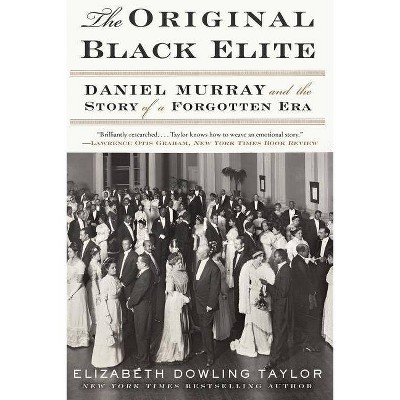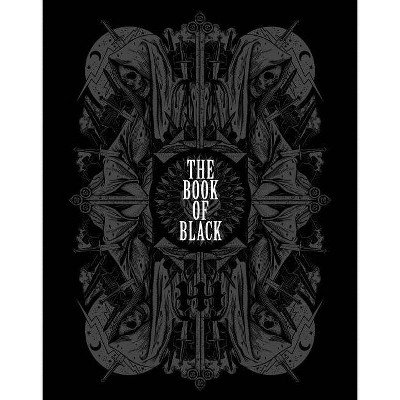The Original Black Elite - by Elizabeth Dowling Taylor (Paperback)

Similar Products
Products of same category from the store
AllProduct info
<p/><br></br><p><b> Book Synopsis </b></p></br></br><p>In this outstanding cultural biography, the author of the <em>New York Times</em> bestseller <em>A Slave in the White House</em> chronicles a critical yet overlooked chapter in American history: the inspiring rise and calculated fall of the black elite, from Emancipation through Reconstruction to the Jim Crow Era--embodied in the experiences of an influential figure of the time, academic, entrepreneur, and political activist and black history pioneer Daniel Murray.</p><p>In the wake of the Civil War, Daniel Murray, born free and educated in Baltimore, was in the vanguard of Washington, D.C.'s black upper class. Appointed Assistant Librarian at the Library of Congress--at a time when government appointments were the most prestigious positions available for blacks--Murray became wealthy through his business as a construction contractor and married a college-educated socialite. The Murrays' social circles included some of the first African-American U.S. Senators and Congressmen, and their children went to the best colleges--Harvard and Cornell.</p><p>Though Murray and other black elite of his time were primed to assimilate into the cultural fabric as Americans first and people of color second, their prospects were crushed by Jim Crow segregation and the capitulation to white supremacist groups by the government, which turned a blind eye to their unlawful--often murderous--acts. Elizabeth Dowling Taylor traces the rise, fall, and disillusionment of upper-class African Americans, revealing that they were a representation not of hypothetical achievement but what could be realized by African Americans through education and equal opportunities. </p><p>As she makes clear, these well-educated and wealthy elite were living proof that African Americans did not lack ability to fully participate in the social contract as white supremacists claimed, making their subsequent fall when Reconstruction was prematurely abandoned all the more tragic. Illuminating and powerful, her magnificent work brings to life a dark chapter of American history that too many Americans have yet to recognize.</p><p/><br></br><p><b> From the Back Cover </b></p></br></br><p>This cultural biography tells the enthralling story of the high-achieving black elites who thrived in the nation's capital during Reconstruction. Daniel Murray (1851-1925), an assistant librarian at the Library of Congress, was a prominent member of this glorious class.</p><p>Murray's life was reflective of other African Americans who were accomplished and prosperous during the Reconstruction period. This social circle included educators, ministers, lawyers, doctors, entrepreneurs, US senators and representatives, and other government officials. Among the luminaries were Francis and Archibald Grimké, Blanche Bruce, Pinckney Pinchback, Robert and Mary Church Terrell, Booker T. Washington, and W. E. B. Du Bois. The elite were primed to assimilate into the cultural fabric as Americans first and people of color second. Education was a pearl of great pride, and they sent their children to the best schools--Phillips Academy, Cornell, and Harvard. They belonged to exclusive clubs, cultivated genteel manners, owned opulent homes, threw elaborate parties, dressed to the nines, and summered in special enclaves.</p><p>But the rug was pulled from under all African Americans when they were betrayed by the federal government as the cost of reconciliation with the South. In response to renewed oppression, Murray and others in his class fought back, establishing themselves as inspiring race activists. Elizabeth Dowling Taylor's powerful work brings to light a dark chapter of race relations that too many have yet to own.</p><p/><br></br><p><b> Review Quotes </b></p></br></br><br>"<em>The Original Black Elite</em> is a compelling biography of Daniel Murray and the group the writer-scholar W.E.B. DuBois called 'The Talented Tenth.' In this work, Elizabeth Dowling Taylor deftly demonstrates how the struggle for racial equality has always been complicated by the thorny issue of class."--Patricia Bell-Scott, author of <i>The Firebrand and the First Lady</i>, which was longlisted for the National Book Award.<br><br>"Elizabeth Dowling Taylor's riveting and timely story of black politicos and professionals--their joys and passions--blazing a trail of equity and excellence in the nation's capital, reminds us all too prophetically how fragile racial progress has been in American history. In this new post-Obama era, <em>The Original Black Elite</em> is a cautionary tale that this "forgotten era" of the first black elite in the highest corridors of power and influence a century ago is not just about the passing of time and the loss of memory. It is about the need to vigilantly learn from the past, never forgetting black progress has always been met with resistance and erasure."--Khalil Gibran Muhammad, author of <em>The Condemnation of Blackness</em><br><br>"A detailed (and, at times, moving) biography... Murray's life underscores the fragility of the black elite."--<i>Minneapolis Star Tribune</i><br><br>"Brilliantly researched...Taylor knows how to weave an emotional story of how race and class have long played a role in determining who succeeds and who fails."--<i>New York Times</i> Book Review<br><br>"Historian Elizabeth Dowling Taylor brings insight to the rise and fall of America's first educated black people."--<i>Time</i> magazine<br><br>"Taylor's book could not be more timely."--<i>Chicago Tribune</i><br><br>"This work reads like a sweeping epic. The level of detail and research sheds light on a period that is mostly forgotten, revealing much-needed insight into African Americans' role and response in the shaping of American culture and politics... Essential."--<i>Library Journal</i><br>
Price History
Price Archive shows prices from various stores, lets you see history and find the cheapest. There is no actual sale on the website. For all support, inquiry and suggestion messages communication@pricearchive.us




















